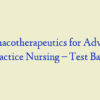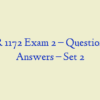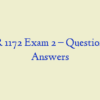Description
BIO 113 Test – Question and Answers
- Why do some scientists consider our piloerector muscles to be vestigial organs?
- Which of the following substances is a compound?
- Most of the cell membrane is made of which lipid?
- Red blood cells that settle out of your blood when left to stand would be considered:
- An example of sonography would be:
- Which of the following would be a use of histology in medicine?
- Explain two things you should consider when designing a scientific experiment to make sure the results are
- What is the atomic mass of an element that has 10 protons, 10 neutrons and 10 electrons?
- Lactose is a __________ that is made of glucose and
- Which of the following shows the organization of a living thing from largest to smallest?
- The three-dimensional conformation of a protein is held together by:
- Give at least three characteristics of all living things and an example of each in the human
- Water molecules being attracted to and sticking to other water molecules is:
- Dehydration synthesis is a reaction that involves the making of a more complex compound ..
- A solution has a pH of 2. The solution would be considered…
- Cells in your skin that can detect a change in temperature would be:
- What are the three parts of a feedback loop?
- The loss of an electron is __________ and the gain of electron is __________.
- A covalent bond in which electrons are not shared equally is called:
- Hydrolysis is a reaction that involves:
- Triglycerides are made up of one __________ molecule and three __________ chains.
- The study of the structure and function of cells is called:
- A substance that helps to mix typically insoluble molecules into water, like bile salts helping fats mix with stomach juice would be:
- Which molecule is a plant structural polysaccharide that we use as dietary fiber?
- Which of the following is most likely to lead to dangerous or even fatal conditions?
- Salts are always formed by what type of bonds?
- Proteins that are mixed in with our blood plasma making it slightly cloudy are an example of:
- Many plant triglycerides are liquid at room temperature because they contain:
- The nucleotide that often acts as second messenger in our cells is:
- What percent of the living cell is made up of water?
- Enzymes speed up reactions by:
- Most lipids are
- A solution with a pH of 8 is how many times more basic than one with a pH of 6?
- This shows the element phosphorous on the periodic Which of the following describes an isotope of phosphorous?
- Name three characteristics of water that make it so important to all living Give an example of how that characteristic is used in the body successfully.
- A buffer…
- The pH of blood:
- What is situs inversus?
- Negatively charged particles that circle the nucleus of an atom are ..
- Nitrogen has an atomic number of 7 and an atomic mass of 01. Which of the following is true:
- The “good” cholesterol that helps to sweep away the bad cholesterol from our blood vessels is called:
- Quaternary structure of a protein would be:
- Match the term with its best definition
- How many valence electrons does sodium have?
- Which of the following would be a use of auscultation in medicine?
- Glucose is a monomer of which of the following polysaccharides?
- Which of the following pH measurements are from lesser to greater acidity?
- Answer the following questions.
- The atomic mass of an atom depends primarily on the number of:
- Carbon is an essential part of living things because it favors covalent How many bonds can one carbon atom make?
- The ability of the body to maintain a constant internal environment is called:
- A substance that can dissolve in water would be a:
- An example of positive feedback in the body would be:
- Explain positive and negative feedback Give pros and cons as well as an example of each in the human body.
- A solution has a pH of 0. The solution is considered a (n)…
- Sugars and salts tend to be:
- Elements are electrically neutral (no net charge), which means the number of __________ must equal the number of __________.
- An example of a conformation change in a protein would be:
- Which of the following bonds in the weakest?
- Cholesterol is the basis of steroids in the body like:
- The full name of ATP is:
- Water will ..
- The copy of DNA that we make in order to synthesize proteins in the body is:
- A solution with a pH of 4 has:
- Which bonds allow electrons to be shared equally between atoms?
- The building blocks of proteins are
- The breaking down of more complex substances into smaller ones is known as:
- Which of the following is an important buffer in the human body?






